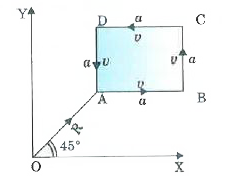A particle of mass m is moving along the side of a square of side a, with a unifrom speed v in XY palne as shown in Fig. Which of the followig statements is false for the angualr momentum →L about the origin?

→L=−mv√2Rˆk, when particle is moving from A→B
→L=−(mv)(R√2−a)ˆk, when particle is moving from C→D
→L=−(mv)(R√2+a)ˆk, when particle is moving from B→C
→L=−mv√2Rˆk, when particle is moving from D→A
The correct Answer is:B, D
In option (a), co-ordinates of A are (R√2,R√2)
∴→r=(R√2ˆi+R√2ˆj) and →v=vˆi
→Lm(→r×→v)=m(R√2ˆi+R√2ˆj)×vˆi
→L=−mR√2vˆk
∴ Option (a) is correct. Similarly, option (c) is correct. Statements (b) and (d) are false.
Similar Questions
Knowledge Check
- Question 1 - Select One
A particle of mass of m is moving along the side of square of side 'a' with a uniform speed u in the X-Y plane as shown in the figure.

Which of the following statements is false for the angular momentum →L about the origin ?A→L=−mv√2Rˆk when the particle is moving from A to B.B→L=mv[(R√2−a]ˆk when the particle is moving from C to D.C→L=mv[(R√2+a]ˆk when the particle is moving from B to C.D→L=mv√2Rˆk when the particle is moving from D to A. - Question 2 - Select One
A particle with the position vector r has linear momentum p. Which of the following statements is true is respect of its angular momentum L about the origin ?
AL acts along pBL acts along rCL is maximum when p and r are parallelDL is maximum when p is perpendicular to r - Question 3 - Select One
A particle with position vector has a linear momentum p. Which of the following statements is true in respect of its angular momentum L about the origin?
AL acts along pBL acts along rCL is maximum when p and r are parallel.DL is maximum when p is perpendicular to r.
A particle of mass m=5kg is moving with a uniform speed v=3√2 in the XOY plane along the line Y=X+4. The magnitude of the angular momentum of the particle about the origin is
View SolutionA particle of mass m=5kg is moving with a uniform speed v=3√2 in the XOY plane along the line Y=X+4. The magnitude of the angular momentum of the particle about the origin is
View SolutionA particle of mass m=5 unit is moving with a uniform speed v=3√2 unit in the XOY plane along the line y=x+4 the magnitude of the angular momentum of the particle about the origin is
View SolutionA particle of mass m=5 unit is moving with a uniform speed v=3√2 unit in the XOY plane along the line y=x+4 the magnitude of the angular momentum of the particle about the origin is
View SolutionA particle moves along the side AB, BC, CD of a square of side 25 m with a velocity of 15ms−1Its average velocity is
 View Solution
View Solution

